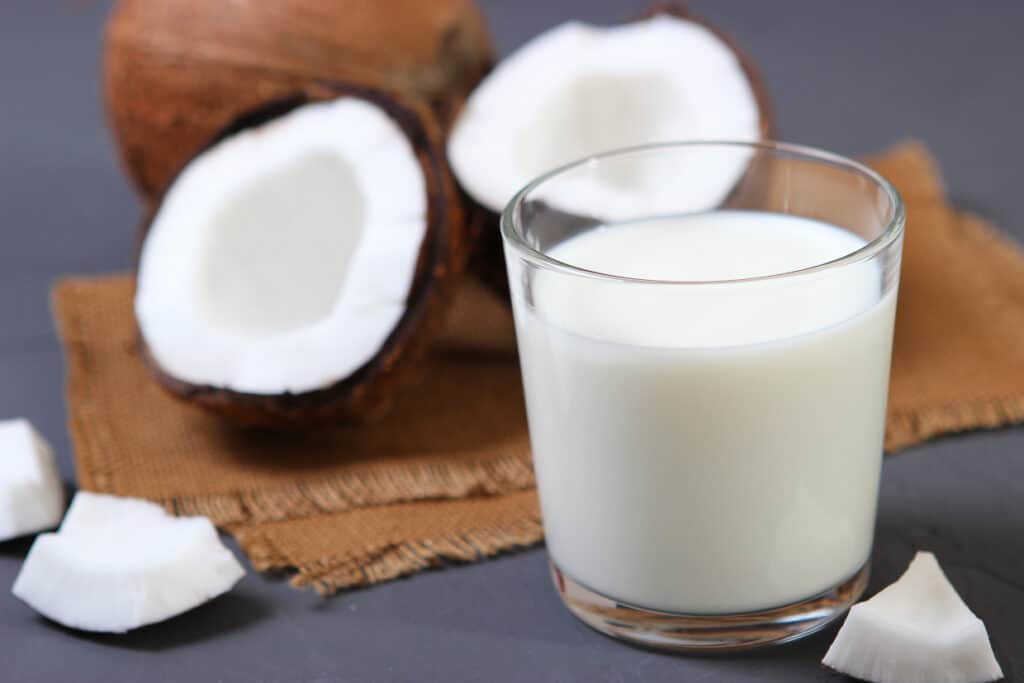The ultimate dairy-free solution, coconut milk offers a rich and creamy texture to your recipes while still being allergy-friendly. Learn about the different kinds of coconut milk and which ones are best for your recipes with the guide below.

What is coconut milk?
Coconut milk is just the flesh of the coconut that’s been blended with water and then strained, leaving a thick, creamy, white milk. It can come in many different varieties.
Coconut milk is most commonly used as a cream replacement in dairy-free baking, as it results in a creamy texture for just about everything. It can be made into a Whole30 whipped cream, a creamy smoothie, a delicious dairy-free alfredo sauce and so much more.
However, there are a lot of varieties on the market. You’ll need to choose from canned coconut milk, full-fat, low-fat, carton and packaged coconut cream. Read on below to learn about the best choices for your dairy-free recipes.
The difference between coconut milk and coconut cream
Coconut cream is made the same way as coconut milk, but more water has been removed to leave a very thick white cream. This can be purchased in a can and will be soft, or a box and will be hard.
Coconut milk is normally liquid at room temperature, though it will firm up in the fridge. The thick white cream is the richest part of the blend and contains the most fat. The better the quality of the product, the more cream will be in the can.
Key things to note:
- Some brands of canned coconut milk will be so thick that the coconut cream and the water have separated in the can. Drain the water and use only the coconut cream on top for your recipes.
- Most canned products are thickened with guar gum that acts as a stabilizer. Avoid canned coconut milk with added sugars, though.
- Liquid coconut milk is great in any baked good, energizing smoothie or curry recipe. However, you want to buy coconut milk with the water separated for coconut whipped cream.
“I love using coconut milk as a substitute for dairy milk or cream in any recipe. It’s quick and easy and doesn’t have an overwhelming coconut flavor. Plus, it adds depth to soups.”
— Gena Lazcano, Ginger Casa
Types of coconut milk
As mentioned, there are a few different kinds to choose from. Just like gluten-free flour and other allergy-friendly baking ingredients, each type of coconut milk has a different purpose, use and reaction when baking.
Coconut milk in a carton
This type of coconut milk is liquid at room temperature and in the fridge. It’s most similar to almond milk in the sense that it’s pourable and made for things like smoothies or cereals. It will also have the most ingredients added to it.
Canned coconut milk
As stated, there are different kinds of canned coconut milk, and the contents often depend on the brand.
- Full-fat coconut milk: This is soft at room temperature and often harden in the fridge. With many brands, you’ll want to open it, drain the water from the can and only use the thick coconut cream for your recipes.
- Hack: Store the canned coconut milk in the fridge upside down. When you open it, the water is on top and easy to pour out as the cream is hard.
- Light coconut milk: This variation has been watered down and is much more liquid. You can use it in most overnight oats and chia pudding recipes, but it won’t work for whipped cream as it doesn’t solidify well.
Brands of coconut milk
Each brand has a slightly different composition of ingredients. This means that the texture of each will be different. So, choose accordingly, depending on what you need it for.
- Cha’s Coconut Milk: The coconut cream and water tend to separate in this brand’s coconut milk, making it easy to use. The coconut cream is often a bit flakey and super concentrated.
- Thai Kitchen: This brand’s coconut milk is a bit thinner and the cream and water are usually not separated when you open the can. It’s not great for whipping.
- Native Forest Coconut Milk: This brand is a favorite for whipped cream because it is super thick and has lots of coconut cream.
How to use canned coconut milk
Canned coconut milk can often be used interchangeably with heavy cream in recipes. Just make sure to use a full-fat version.
It is commonly used in overnight oats, to make chia pudding recipes indulgent and as a whipped topping on recipes like brownies. If you need to add richness to anything, you can use coconut milk.
How to store coconut milk
Once opened, you must store it in the fridge. Know that a carton of coconut milk will maintain its liquid texture. However, if it is canned, especially the full-fat kind, it will thicken up and sometimes become hard, depending on the quality.
This also goes for recipes with coconut milk as the base. Recipes like chocolate ganache or caramel sauce will thicken in the fridge and need to be heated again.
Wrapping up
Coconut milk is a healthy, easy, dairy-free alternative to milk and cream in baked goods. Choosing the right kind for your recipes can enhance the flavor and texture of your dishes while allowing you to avoid an allergen. By experimenting with coconut milk in the kitchen, you can take your expertise to a whole new level.
Meet Shelby — a Strength & Nutrition Coach and the person behind the blog Fitasamamabear.com. As a mom of three young girls and coach for the past ten years, Shelby helps make healthy food and strength training at home easy for busy moms. Her ultimate goal is to help moms increase energy, keep up with their kids, and feel confident in the skin they’re in.
This article originally appeared on Fit as a Mama Bear.